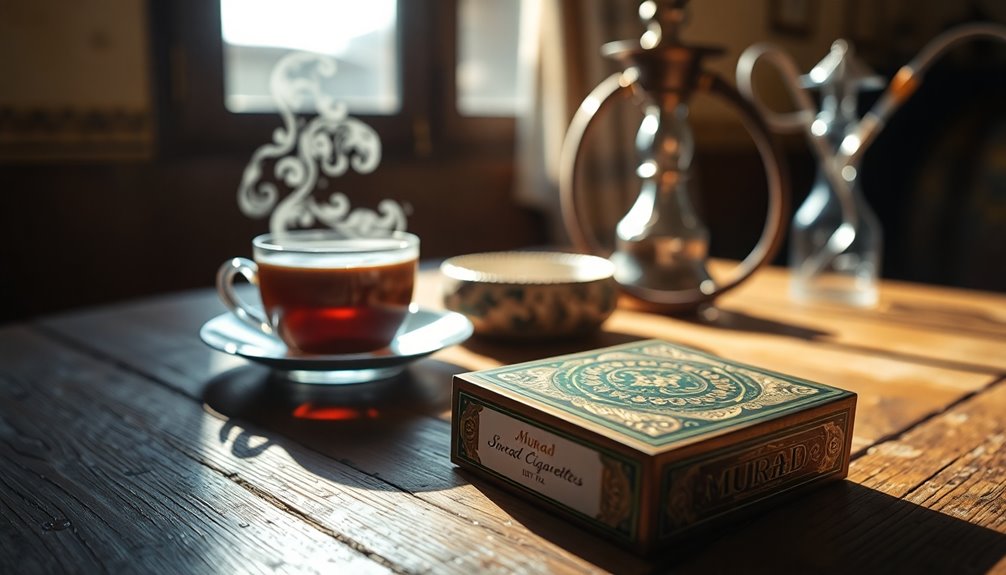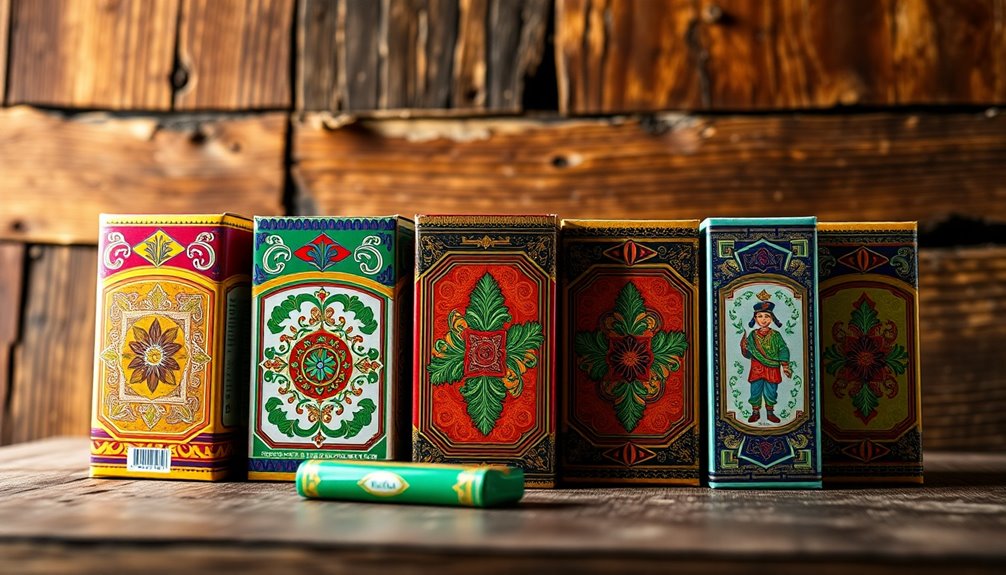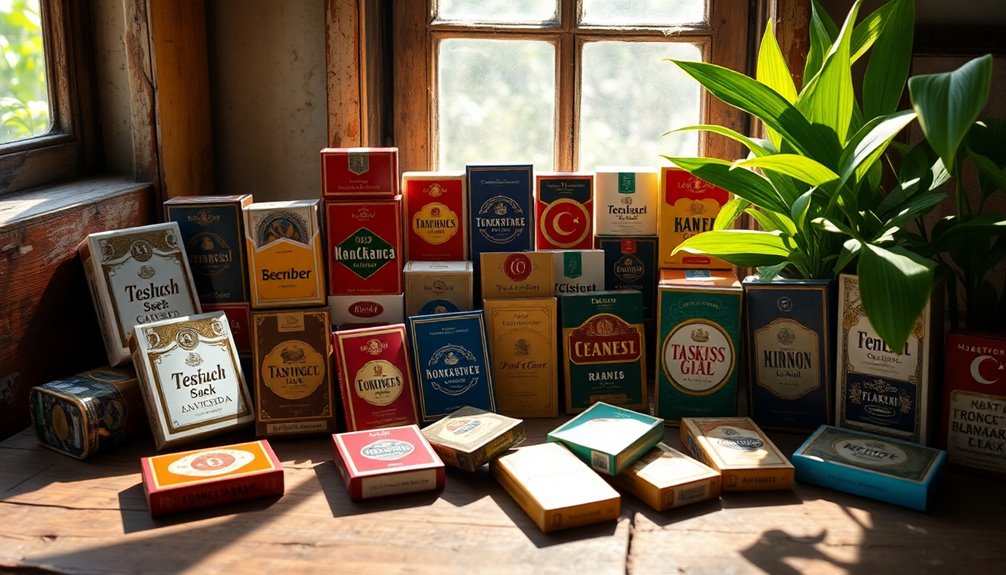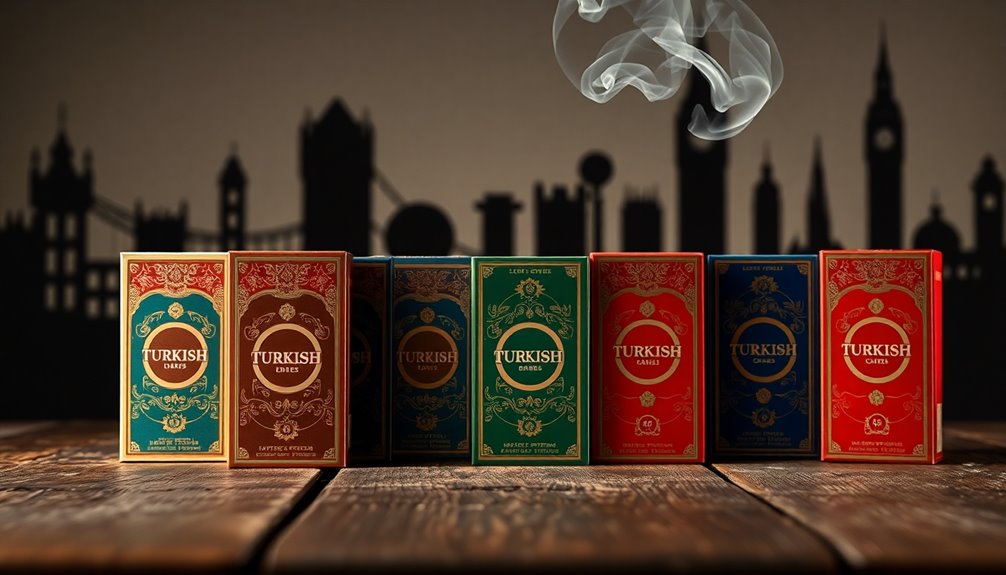Murad Cigarettes have secured their place in Turkish culture due to the exclusive use of high-quality Turkish tobacco, known for its rich flavors and aromatic qualities. Their unique marketing strategies, emphasizing exotic themes and luxury, have drawn consumers for over a century. You'll appreciate their historical significance, from collectible cigarette cards to their reflection of bygone societal values. Despite challenges in the tobacco market, Murad has adapted and maintained strong appeal among both traditional and modern smokers. If you're curious about how this historical brand continues to thrive, there's plenty more to uncover.
Key Takeaways
- Murad Cigarettes exclusively use high-quality Turkish tobacco, offering a distinct flavor profile that appeals to local tastes.
- The brand's rich history and cultural significance resonate with consumers, symbolizing traditional smoking practices in Turkey.
- Unique marketing strategies, featuring exotic themes, enhance the brand's allure and position it as a luxury product.
- Collectible cigarette cards foster brand loyalty and engagement, creating a nostalgic connection among consumers.
- Despite market challenges, Murad maintains strong recognition and adapts to modern consumer preferences, ensuring its ongoing popularity.
History of Murad Cigarettes

Murad Cigarettes' history begins with Soterios Anargyros, a Greek tobacconist in New York who crafted hand-rolled cigarettes using pure Turkish tobacco. In the early 1900s, as demand for Turkish and Egyptian cigarettes surged, Murad emerged as a legitimate competitor to leading brands. This growth caught the attention of P. Lorillard, who acquired the brand in 1911 after the Cigarette Trust dissolved.
Marketing played a crucial role in Murad's success. Advertisements highlighted the exotic roots of Turkish tobacco, drawing inspiration from Eastern fashion trends influenced by the Ballets Russes. Vibrant colors and luxurious imagery portrayed both men and women in lavish attire, positioning them as modern and adventurous, a stark contrast to the traditional Victorian ideals of femininity. Additionally, the brand's advertising strategies were characterized by an emphasis on Orientalism, which further enhanced its appeal.
To further engage consumers, Murad issued collectible cigarette cards around 1910, showcasing university colors, sporting scenes, and decorative silk cards. These cards not only stiffened cigarette packaging but also fostered brand loyalty, offering directions for creating household items from the silk.
Though Murad's popularity waned with the rise of American cigarettes, its historical significance in advertising and marketing strategies remains evident today, making its collectibles sought after by enthusiasts.
Unique Tobacco Production
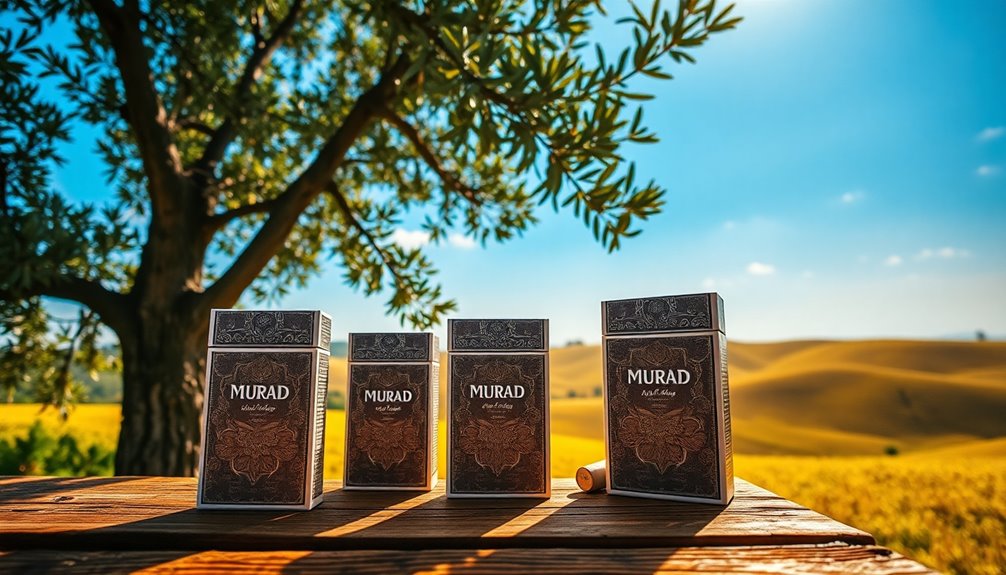
The unique production of Turkish tobacco sets Murad Cigarettes apart in the crowded market of the early 20th century. Unlike American tobacco, Turkish tobacco features smaller, more numerous leaves, known for their aromatic and acidic qualities thanks to the sun-curing process. This method, developed over centuries, enhances the distinctive flavor profile that fans of Murad Cigarettes appreciate.
Historically cultivated in regions like Thrace and Macedonia, the climate and soil of Turkey significantly influence the tobacco's unique characteristics. While cultivation has spread to countries like Egypt and South Africa, the limited growth capacity of Turkish tobacco contributes to its high cost, making it one of the most expensive types in cigarette blends. Over 700 billion cigarettes are produced annually, highlighting the scale of tobacco production globally.
This tobacco variety isn't just about its origin; it's also about its careful treatment and blending. Murad Cigarettes traditionally used Turkish tobacco exclusively, providing a rich, aromatic experience that stands out.
The sun-curing method helps maintain the quality and character, ensuring that each puff delivers a unique flavor. For those who appreciate a distinct smoking experience, Murad Cigarettes embody the essence of Turkish tobacco production.
Marketing Strategies and Campaigns
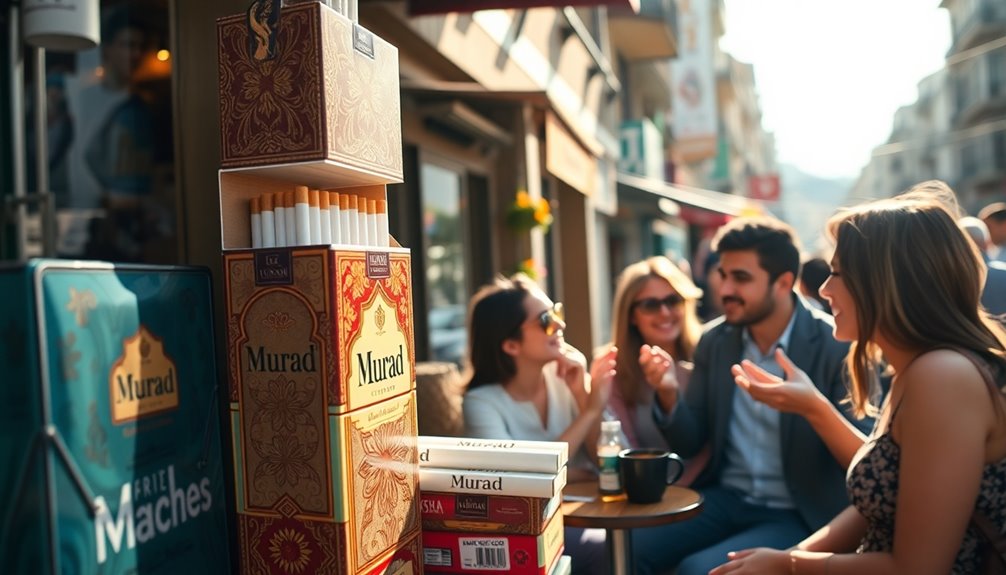
In a crowded market, Murad Cigarettes stood out through clever marketing strategies that captivated consumers. The brand embraced oriental and exotic themes, showcasing the rich heritage of Turkish tobacco through vibrant pack art and advertisements. You'd notice the allure of Eastern-inspired fashion, featuring elegant women in flowing dresses and men in luxurious suits, creating an atmosphere of sophistication and modernity. Their advertising imagery was nothing short of spectacular, often described as "gorgeously over-the-top." Murad's campaigns included elaborate, fantastical scenes that combined modern elements with exotic flair, capturing your attention. High-quality visuals featured women as enchanting figures, embodying both allure and strength. Murad effectively targeted social status, positioning its cigarettes as symbols of luxury and pleasure. Advertisements promoted the refreshing, focusing, and calming effects of smoking, appealing to both men and women with tailored messages. The success of these strategies is reflected in the auction results, where a Murad Advertising Sign sold for $397.64.
Collectible Cards and Memorabilia

Featuring vibrant imagery and historical significance, collectible cards from the T51 Murad Cigarettes College Series have become a sought-after treasure for enthusiasts.
Issued around 1910, these cards showcased university colors, pennants, and seals from various colleges, including Huron, Amherst, and Stanford. You'll find scenes from sports like baseball, football, and golf adorning these pieces, making them not just collectibles, but a slice of history.
Each card measures 2 ½ inches by 2 inches and was initially included in cigarette packs to stiffen the packaging and foster brand loyalty. The series represents a variety of sports beyond basketball, highlighting the early college sports landscape in America.
Grading organizations like PSA and SGC assess these cards, providing grades that range from SGC 1 to SGC 4, and PSA 3. Higher grades indicate better condition and rarity, which can significantly elevate a card's market value.
Prices typically range from $33.95 to $99.95, with well-preserved cards fetching higher amounts.
The age of these cards, being over a century old, coupled with their representation of early college sports, adds to their allure for collectors.
Certified cards offer authenticity, further enhancing their desirability and value in the collectible market.
Decline of Turkish Cigarettes

Turkish cigarettes, once a symbol of luxury and exoticism, have seen a significant decline in popularity over the past century. The rise of American cigarettes, particularly Virginia tobacco, shifted consumer preferences away from traditional Turkish varieties during and after World War I.
As European and US markets increasingly favored these alternatives, brands like Murad, Fatima, and Helmar struggled to maintain their foothold. Economic factors played a crucial role as well. The dissolution of the Cigarette Trust and the lack of regulatory support left Turkish cigarette brands vulnerable.
While Turkey implemented various tobacco control measures, they didn't favor local brands, and manufacturing incentives typically benefited mass-produced cigarettes. Furthermore, the annual economic cost attributed to smoking and tobacco use in Turkey reached 85,332 million Turkish liras, highlighting the financial burden on families that this decline has exacerbated.
Additionally, marketing strategies that once highlighted the exotic allure of Turkish cigarettes failed to adapt to changing consumer tastes. As health awareness grew and the luxurious image lost its appeal, younger generations turned to new trends.
With advertising restrictions tightening, brands could no longer effectively reach their audience, leading to a further decline in their market presence. Ultimately, the combination of shifting consumer preferences, economic challenges, and evolving cultural trends has led to the diminished status of Turkish cigarettes in the modern marketplace.
Cultural Significance and Legacy

The decline of Turkish cigarettes marks not just a shift in consumer preferences but also a change in cultural representation within the tobacco industry.
Murad cigarettes, with their rich heritage, utilized Eastern-inspired imagery and themes to craft a luxurious allure around their product. You'd see advertisements featuring women in harem pants and men in exotic turbans, evoking a sense of exoticism that aligned with the era's fascination with the Orient. The vibrant colors and opulent settings portrayed Turkish tobacco as not just a smoke but a lifestyle. The production of sun-cured Turkish tobacco enhanced the aroma and acidity, further elevating its appeal.
Their advertising strategies reinforced this image, using cigarette cards that highlighted university pride and social status, making the brand feel inclusive yet exclusive. By emphasizing the pleasurable aspects of smoking, Murad positioned itself as a source of enjoyment and relaxation for consumers across various social groups.
This marketing not only differentiated Murad from its competitors but also contributed to a broader cultural narrative surrounding Turkish tobacco.
The legacy of Murad cigarettes endures as a reflection of a time when smoking was intertwined with identity, status, and fantasy, leaving an indelible mark on the tobacco landscape in Turkey and beyond.
Frequently Asked Questions
What Are the Health Effects of Smoking Murad Cigarettes?
Smoking Murad cigarettes can lead to serious health issues.
You increase your risk of cancer, particularly in the lungs, throat, and mouth, due to harmful chemicals found in tobacco smoke.
Your heart health suffers as smoking damages blood vessels and raises the chances of heart disease and stroke.
Additionally, you might experience respiratory problems like COPD and reduced lung function.
How Do Murad Cigarettes Compare to Other Turkish Brands?
When you compare Murad cigarettes to other Turkish brands, you'll notice that Murad stood out for its pure Turkish tobacco and hand-rolled quality.
While Murad was once a significant competitor, modern brands like Tekel and Istanblue focus on innovative products such as flavored and ultra-slim options.
Additionally, today's Turkish market is dominated by international players, which differ greatly from the historical presence and unique characteristics of Murad cigarettes.
Where Can I Find Vintage Murad Cigarette Packs?
You can find vintage Murad cigarette packs in several places.
Start by checking online marketplaces like Etsy, where you might discover metal cigarette boxes from the 1900s, often priced around $40.
Additionally, specialized collectible shops like MINT State Inc. may have options, although stock can fluctuate.
Lastly, museums like the Smithsonian offer online views of their collections, providing a historical perspective on these unique items.
Happy hunting!
Did Murad Cigarettes Have Any Celebrity Endorsements?
Yes, Murad cigarettes did have celebrity endorsements.
Back in the early 1900s, they enlisted well-known figures like silent film star Roscoe "Fatty" Arbuckle and comedian Harry Bulger to promote their brand.
These endorsements aimed to attract "cultivated men" and were part of a broader marketing strategy that included luxurious advertising.
While they created a significant impact initially, Murad's popularity eventually waned as other brands took the spotlight in the 1930s.
Are There Any Current Alternatives to Murad Cigarettes?
If you're looking for current alternatives to Murad cigarettes, you might want to explore brands like Bahar Kirmizi, Istanblue Blue, and Tekel 2000, which are popular in Turkey today.
Major companies like Philip Morris International and Japan Tobacco also dominate the market.
They've shifted focus from traditional Turkish blends to cater to changing consumer preferences.
You'll find that convenience stores are your best bet for accessing these brands in Turkey.
Conclusion
In conclusion, Murad cigarettes have carved a unique niche in Turkish culture, blending history with a distinct tobacco production process. Their clever marketing strategies and collectible memorabilia further solidified their place in the hearts of many. Despite the decline of Turkish cigarettes, the legacy of Murad endures, reminding us of a time when these smokes were a cherished part of daily life. You can't help but appreciate their impact on both the past and present of Turkish smoking culture.
